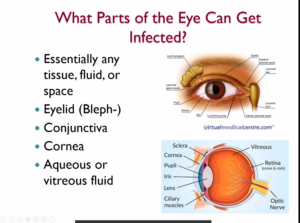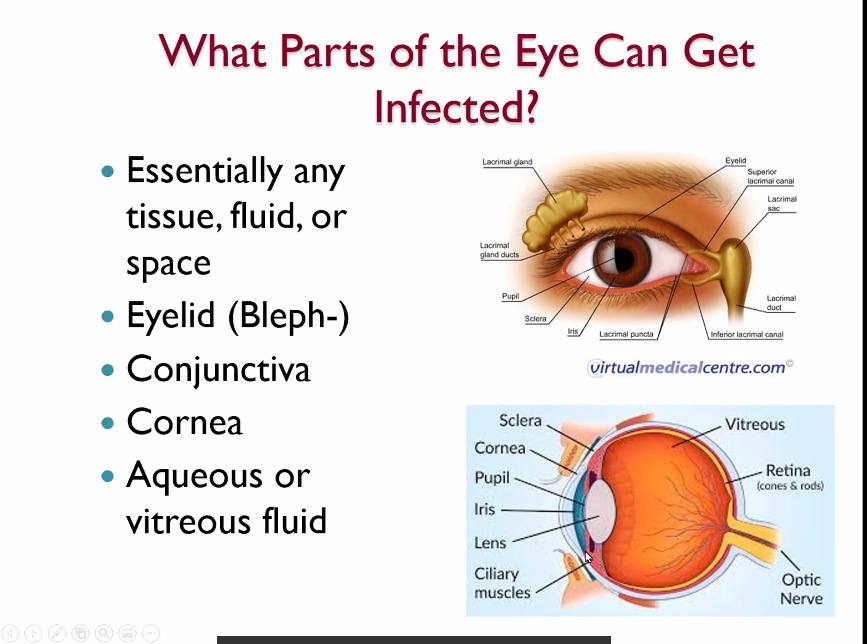The University of Pittsburgh has the unique privilege of having an ophthalmic microbiology laboratory. There are not too many around nationally, according to Dr. Alex Mammen, MD, Clinical Assistant Professor of Ophthalmology, Cornea, Cataract, External Disease, and Refractive Surgery at the University of Pittsburgh and medical director of the UPMC Charles T. Campbell Ophthalmic Microbiology Laboratory. He said they have been absorbed into the larger labs.
“It really changes the way we can practice ophthalmology and improve patient care to have a specialty lab as part of the Department,” he said in the Eye & Ear Foundation’s February 25 webinar, “Understanding Common Eye Infections.”
The lab’s mission was explained by Regis Kowalski, MS, M(ASCP) – Executive Director of the Charles T. Campbell Ophthalmic Microbiology Laboratory and Chief Clinical Ophthalmic Microbiologist at the University of Pittsburgh Medical Center Health System:
- Diagnostic (definitive and timely) detection of infectious diseases of the eye for patient care
- Explore and validate new practical tests for detecting ocular pathogens
- Investigate new anti-microbial agents (anti-infectives, anti-virals, antiseptics, biocides)
- Monitor ocular infections and anti-infective susceptibles
When diagnosing eye infections, it is especially useful having the lab readily available to identify causes. Before Dr. Mammen described some common eye infections, he showed a diagram of what parts of the eye can get infected.

Hordeolum (Stye)
Essentially, this is like a pimple of the eyelid, Dr. Mammen said. It is a blocked oil gland within the eyelid that can be associated with a staph infection. Treatment includes a warm compress, combination antibiotic and steroid ointment, and an oral antibiotic if the infection is more severe.
Blepharo-conjunctivitis treatment
Antibiotic drops and ointment are used to treat this eye infection. The eyelid hygiene regimen involves the following:
- Warm compresses
- Eyelid wipes (baby shampoo and soft cloth)
- Commercially available wipes (Ocusoft)
Moraxella
This is another case of bacterial conjunctivitis that has more drainage. It is fairly susceptible to the majority of antibiotics, so there are many options for treatment.
Viral Conjunctivitis
This is usually caused by the same kind of virus that causes the common cold. Typically, this eye infection self-resolves in 7-10 days. Supportive care involves lubricating drops and cool compresses.
More severe viral conjunctivitis can be more symptomatic and uncomfortable depending on the strain. Steroid eye drops are used to calm down inflammation.
Pseudomona
This is a common bacteria associated with contact lenses. It can eat away at the cornea very quickly, so treatment means aggressive antibiotic eye drops.
Endophthalmitis
This can occur after cataract surgery and comes from the skin. If severe enough, it can result in loss of the eye. It is important to have good sterile techniques before and during surgery. Treatment is an antibiotic injection to the eye. Sometimes surgery is needed depending on the infection’s severity.
The Campbell Laboratory
Kowalski explained how the lab monitors ocular infections. The objective is to determine what causes the infections and the prevalence of those agents. He then shared the future of ophthalmic microbiology at the Campbell Lab:
- Better validated methods to detect ocular pathogens
- Improved approaches to treat infectious ocular disease
- Cutting edge methods to definitively identify microbial pathogens
Q&A
Dr. Mammen provided the following tips to avoid eye infections:
- Wash/sanitize hands often
- Avoid touching your eyes, esp if you haven’t just washed your hands
- Practice good contact lens hygiene incl do not sleep in them
- If you’ve had eye surgery, take care to avoid contaminating your eyes or eye drops
- Wear good eye protection as appropriate
Food for thought: the adenovirus is a respiratory virus that can linger on surfaces for a week – and as long as seven weeks. And an eye infection can be debilitating, even changing one’s life.
The next frontier in ophthalmic microbiology research is testing for fungal infection. Nothing grows despite a culture, so having other ways to detect what the microorganism is will be useful.
How long it takes for patients to recover from an eye infection depends on the type and severity of the infection, as well as the microorganism. Usually patients recover within a week, Dr. Mammen said.
People with dry eye are more likely to get eye infections. Keeping the eyes well lubricated not only helps the eyes feel better, but to see better.
One viewer noted that both Dr. Mammen and Kowalski were wearing glasses and asked why they opt for them over contact lenses. Kowalski said if he wears contacts, he will get an eye infection. “I would never live that down,” he said.
Dr. Mammen likes the extra protection his glasses provide. He does not mind how he looks with glasses and has gotten used to them. He used to wear contacts and then developed an intolerance to them, which is the main reason he no longer wears them. “Just because I wear glasses doesn’t mean I don’t believe in refractive surgery in the right person,” he said. “As long as we do the proper education and you understand what’s involved, it’s a great option.”
